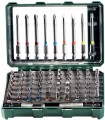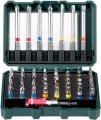Total number of items
The total number of items in the set. In this case, both the actual
bits and end heads are taken into account, as well as additional accessories such as an adapter, a bit holder, etc.
The more items in the set, the wider its possibilities. However, note that the specific composition of the kit may be different, so when buying it is worth specifying not only the number of items, but also their specific types.
SL bits (Slot)
The total number of
bits of type SL supplied in the set.
Marking SL means bits with the simplest flat tip. For such a tip, in principle, strict compliance with the size of the slot in the fastener is not necessary — it can be a little narrower or a little wider. In addition, flat-slot fasteners are used relatively rarely today, more advanced varieties have become more common. Therefore, the SL-type bit in the kit, usually, is not much.
SL bits sizes
The sizes of the SL type bits included in the set and the number of bits of each size.
For the bits themselves, see above. The size is indicated by a number indicating the width in millimetres; if the bit is more than one, after the size their number is specified. For example, the marking "SL4, SL6x2" means one bit for 4 mm and two for 6 mm.
PH cross bits (Phillips)
The total number of
bits of type PH supplied in the set.
The PH marking stands for a classic cross-shaped tip without additional tricks. These bits have a larger area of contact with fasteners than flat SL bits and allow you to work at higher torques. At the same time, when the load increases to a certain level, such a tip pops out of the slot. In some situations, this is an advantage, because avoids damage to the tip and fasteners due to too much force; however, other types of tips, such as PZ, are better for working at maximum forces (see the relevant paragraph).
PZ cross bits (Pozidriv)
The total number
of PZ type bits supplied in the set.
The PZ is a modified version of the PH cross tip (see the relevant paragraph). In PZ tips, the angles are more pronounced, there are additional edges to increase the contact area with the slot — thanks to this, unlike PH, these tips do not push out of the slot even with a very large effort. All this makes the PZ a fairly convenient option for working at high loads, including uneven — in particular, for tightening self-tapping screws.
T bits (Torx)
The total number
of Torx bits supplied in the set.
The Torx tip has the shape of a six-pointed star. This provides a larger area of contact with the fastener than flat and cross bits, and allows you to work with higher forces.
H bits (Hex, Allen)
The total number
of Hex bits supplied in the set.
The Hex tip has the shape of a regular hexagon. Fasteners of this type are easy to use due to the large size of the slot — this makes it easier to get into it with a nozzle. And the nozzles themselves are somewhat inferior to the Torx “stars” in terms of the contact area with the slot, but they are noticeably superior to the cross nozzles.
H, HH bits sizes
The sizes of the Hex bits included in the set, and the number of bits of each size.
For the bits themselves, see above. The size is indicated by a number indicating the width in millimetres — for example, H2.5 or H4. If there are several bits of the same size, their number may be specified after the size, but in the case of Hex-bits this is extremely rare, they are usually supplied one of each size.
Bit holder
The number of bit holders supplied in the set.
In most cases,
a bit holder is a kind of "extension" for bits of standard length, designed to be installed in a screwdriver (extended bits can be installed without a bit holder). On one side of this "extension" there is a seat for complete bits, on the other — a standard hex shank. In some cases, such a device can even be used as an improvised screwdriver if there is no full-fledged screwdriver handle at hand.
In addition, some manufacturers call bit holders adapters from a hexagonal bit shank to a landing square of one size or another.
There is rarely more than one bit holder, however, there are exceptions to this rule when holders have different shank sizes.

